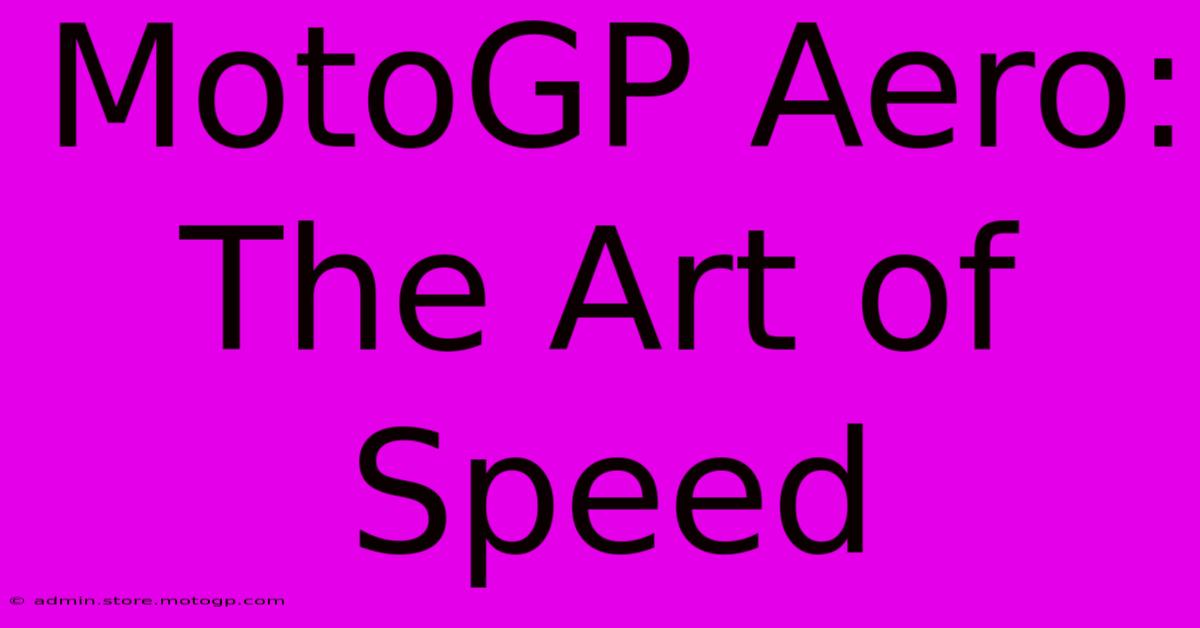MotoGP Aero: The Art Of Speed

Table of Contents
MotoGP Aero: The Art of Speed
MotoGP racing isn't just about powerful engines and skilled riders; it's a finely tuned dance between man and machine, where even the smallest aerodynamic advantage can mean the difference between victory and defeat. This intricate ballet is largely orchestrated by MotoGP aero, a complex field constantly pushing the boundaries of speed and performance. Let's delve into the world of aerodynamic advancements that shape the thrilling races we witness.
Understanding the Aerodynamics of MotoGP Bikes
MotoGP bikes, traveling at speeds exceeding 200 mph (320 km/h), face immense aerodynamic forces. These forces, including drag and lift, significantly impact performance. Drag resists the bike's forward motion, reducing speed and acceleration. Lift, on the other hand, pushes the bike upwards, reducing traction and stability, especially during cornering.
The Role of Aerodynamic Components
To counteract these forces, MotoGP bikes are equipped with an array of sophisticated aerodynamic components:
- Fairings: The sleek bodywork, or fairing, is meticulously designed to minimize drag and manage airflow. Every curve and angle is carefully calculated to optimize performance.
- Wings: These prominent additions, often located on the front and rear of the bike, generate downforce. Downforce presses the bike onto the track, increasing grip and stability at high speeds, allowing for faster cornering. The design and placement of these wings are crucial, influencing both downforce and drag.
- Winglets: Smaller wings or winglets are often integrated into the fairing, further refining airflow and enhancing downforce. Their strategic placement minimizes disruption to airflow and maximizes aerodynamic efficiency.
- Air ducts and vents: These manage airflow around the engine and rider, cooling components and reducing drag by directing air more efficiently. Clever routing of air can significantly enhance performance.
The Constant Evolution of MotoGP Aero
MotoGP aero is a dynamic field, constantly evolving with new innovations and regulations. Teams employ cutting-edge Computational Fluid Dynamics (CFD) simulations and wind tunnel testing to refine their designs. This ongoing development leads to a fascinating arms race, with each team striving to gain a competitive edge through aerodynamic improvements.
The Impact of Regulations
The governing body, FIM, imposes regulations on aerodynamic components to maintain a degree of fairness and safety. These regulations often limit the size and shape of wings and other aerodynamic devices, preventing teams from creating excessively aggressive designs that could compromise safety or create an unfair advantage. These regulations frequently change, forcing teams to constantly adapt and innovate.
The Rider's Perspective: Mastering Aerodynamic Forces
While engineers design the aerodynamic components, the riders play a crucial role in harnessing their performance. They must adapt their riding style to manage the increased downforce and changing airflow around the bike. The rider's skill in handling these aerodynamic forces is essential to maximizing speed and control. A skilled rider can feel and interpret the aerodynamic effects, adjusting their position and inputs accordingly.
The Future of MotoGP Aero
The future of MotoGP aero promises even more sophisticated designs and technologies. We can expect to see further integration of advanced materials, more refined simulations, and potentially even more radical aerodynamic solutions as teams push the limits of performance within the regulatory framework. The pursuit of speed through aerodynamic efficiency remains a central theme in MotoGP, ensuring the sport’s continued excitement and technological advancement.
Keywords: MotoGP Aero, MotoGP Aerodynamics, Motorcycle Aerodynamics, Downforce, Drag, Wings, Winglets, Fairings, CFD, Wind Tunnel, MotoGP Technology, Racing Technology, MotoGP Regulations, Aerodynamic Efficiency, MotoGP Bikes, MotoGP Speed
This article uses a variety of SEO techniques, including keyword optimization, H2 and H3 headings for structure, bold text for emphasis, and a comprehensive overview of the topic. Remember to promote this article through social media and other channels to increase its visibility.

Thank you for visiting our website wich cover about MotoGP Aero: The Art Of Speed. We hope the information provided has been useful to you. Feel free to contact us if you have any questions or need further assistance. See you next time and dont miss to bookmark.
Featured Posts
-
Moto Gp Helmet Technology What You Need To Know
Feb 18, 2025
-
Lub Si Cota Overcoming Fear And Doubt
Feb 18, 2025
-
Maximize Your Race Day The Cota Parking Guide
Feb 18, 2025
-
The Legacy Lives On Vintage Racing Helmet Replicas
Feb 18, 2025
-
Get Closer To The Action At Moto Gp Tracks
Feb 18, 2025
